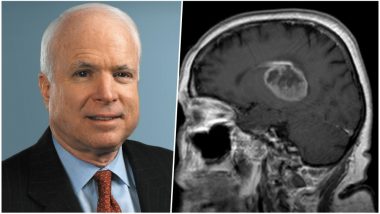Senator John McCain first shot to worldwide fame in 2008 when he contested alongside Barack Obama and Sarah Palin for the presidential elections. But he’s was also a celebrated war hero who survive five years of brutal torture as a prisoner of war in a Hanoi prison during the Vietnam War. In 1967, he was captured by the Vietnamese militia when he served as lieutenant commander in the naval air force. Despite being subjected to extreme brutality, McCain never yielded to his captors, even enduring two years of solitary confinement. He also refused an early release from the torture camp unless the POWs before him were released. But the tough-as-nails politician McCain lost the battle at age 81 to an unlikely yet equally lethal nemesis – Glioblastoma, the deadliest form of brain cancer known to man. His diagnosis was announced to the media in July 2017. On August 24, it was officially announced that he wouldn’t continue his treatment for glioblastoma and a day later, the world was informed of his demise.
What is Glioblastoma?
Glioblastoma also known as glioblastoma multiforme is the most aggressive form of cancer, making up for 16 percent of all primary malignancies of the brain and the central nervous system. Unlike other forms of cancer, glioblastoma doesn’t spread to other parts of the body. The high-grade type IV cancer typically originates in the glial cells found in the supportive tissue of the brain and are commonly found in the cerebrum. In March, Indian actor Irrfan Khan was rumoured to be suffering from glioblastoma, which was then refuted.
Although the glioblastoma occurs mostly in the cerebrum, it can also appear in the brain stem, cerebellum and the spinal cord. It presents itself at the median age of 64, affecting more men than women. It’s seen more in Caucasians than in other ethnicities. According to the National Brain Tumour Society, patients with glioblastomas have a median survival rate of 15 months.
What Are The Symptoms and Risks?
Since these tumours appear mainly in the cerebrum, all the functions associated with the four lobes related to cognition, reasoning, speech, perception, touch, language and memories get affected. According to the Mayo Clinic, symptoms of glioblastoma include headache, nausea, vomiting, confusion, memory loss, speech difficulties, urinary incontinence, vision problems and seizures.
Age and gender play a big part in increasing glioblastoma risk. Men above the age of 45 and 65 are more at risk. Exposure to radiation and family history are other risk factors.
Why Is Glioblastoma So Deadly?
According to the National Foundation For Cancer Research, glioblastoma kills 95 percent of the patients within five years of diagnosis and half of them die within the first 15 months. Deadly cancer also has a high rate of recurrence, relapsing in 90 percent of all patients. Glioblastoma cells reproduce quickly and are made up of different types of cells, which make treatment difficult. It is difficult to extract the tumour completely because it has finger-like tentacles that grow into adjacent brain tissues. When the tumours recur, the molecular profile of the tumour changes completely. That’s why the results of the treatment can vary and less than five percent of the patients survive.
Notable Cases of Glioblastoma
The most famous case of glioblastoma in the recent years was that of 29-year-old Brittany Maynard from the US, who decided to end her life through a physician-assisted suicide in 2014. Brittany, in many ways, didn’t fit the profile for a glioblastoma patient. She was a young woman in her prime. Her decision to die with dignity triggered many right-to-die debates in the country.
American politician Edward Kennedy died of glioblastoma in 2009, eerily on the same date as McCain did – August 25. Joe Biden, who was a long-time friend of McCain, also lost his son Beau to the deadly disease. He then started the ‘Beau Biden Foundation’ in his memory. Biden has also appeared alongside McCain’s daughter Megan to create awareness about the deadly cancer.
Possible Treatment Options
The treatment options for glioblastoma are limited to surgery, radiation and chemotherapy, despite which the tumours almost always relapse. That’s mainly due to the aggressive nature of the tumours and the brain’s limited capacity to heal itself. The blood-brain barrier, which stops toxic substances from entering the brain, also limits many drugs from working. Alternating electric field therapy is an upcoming FDA-approved treatment measure for newly diagnosed and recurrent glioblastoma.
(The above story first appeared on LatestLY on Aug 27, 2018 04:32 PM IST. For more news and updates on politics, world, sports, entertainment and lifestyle, log on to our website latestly.com).













 Quickly
Quickly


